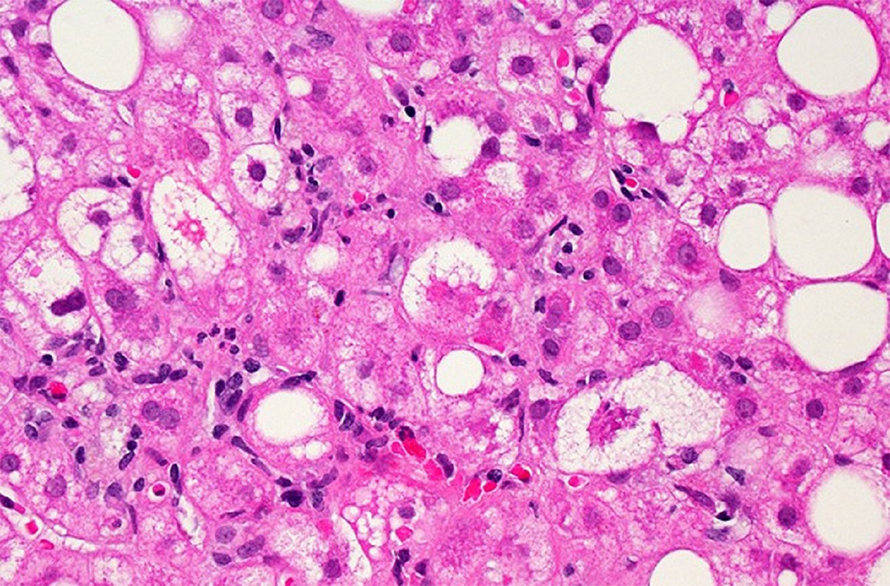From the journals: JLR
A molecular mechanism of liver disease treatment. How tissues regulate octanoate. A perilipin’s role in cholesterol balance. Read about papers on these topics recently published in the Journal of Lipid Research.
A mechanism of liver disease treatment
Nonalcoholic fatty liver disease, or NAFLD, causes liver swelling and sometimes cirrhosis due to excess fat accumulation. Epigenetic modification — specifically 5-methylcytosine, or 5mC, methylation — regulates gene expression, and a drug for NAFLD, 25-hydroxycholesterol 3-sulfate, or 25HC3S, now in clinical safety trials, plays a role in global regulation of gene expression. Previous research has suggested that 25HC3S is an epigenetic regulator.
Yaping Wang and a team based at Virginia Commonwealth University and the McGuire Veterans Affairs Medical Center published a paper recently in the Journal of Lipid Research elucidating the molecular mechanism of 25HC3S. The researchers determined that 25HC3S inhibited the activity of three DNA methyltransferases (DNMT-1, DNMT-3a and DNMT-3b) and reduced 5mC methylation in promoter regions of key genes. They also found that demethylation by 25HC3S regulated the expression of genes involved in various signaling pathways.
Using whole-gene expression analysis of human hepatocytes treated with 25HC3S, the team found that cell survival–associated pathways were upregulated, while lipid metabolism–associated pathways were downregulated. This study provides key mechanistic details for how intracellular oxysterol sulfates, such as 25HC3S, regulate cell-signaling pathways at the transcriptional level in hepatocytes to treat NAFLD effectively.
The researchers proposed that inhibition of DNMTs by 25HC3S could lead to demethylation, which increases gene expression of several pathways. These pathways include ones responsible for blocking cell apoptosis; increasing cell proliferation; and blocking cholesterol, fatty acid and triglyceride biosynthesis. Overall, the results of this study provide information that could be useful in developing new treatments for NAFLD and other chronic diseases.

How tissues regulate octanoate oxidation
Cardiac hypertrophy is a disorder characterized by the thickening of the heart muscle, and researchers have found evidence suggesting it sometimes is caused by defects in mitochondrial fatty acid oxidation, or mFAO. Some individuals with this condition have genetic deletions of CPT1 and CPT2, two enzymes important in the mitochondrial oxidative pathway that metabolizes fatty acids. Therapies for cardiac hypertrophy include a medium-chain fatty acid diet, although researchers do not yet know the molecular effects of this therapy.
In a recent paper in the Journal of Lipid Research, Andrea Pereya and a team from three U.S. universities describe how they determined that octanoate, a medium-chain fatty acid, had no effect on cardiac hypertrophy or pathological hypertrophy genes in mice that have a genetic deletion of CPT2. The researchers determined that liver mitochondria, not heart or skeletal muscle, oxidizes free octanoate and highly expresses mitochondrial medium-chain acyl-CoA synthases, or ACSMs. They also found that each type of tissue (liver, heart and skeletal muscle) oxidized an important metabolite of octanoate in the mFAO pathway, octanoylcarnitine, and they proposed a model wherein the liver oxidizes free octanoate via ACSMs and each tissue can metabolize octanoylcarnitine, which then is converted back to octanoyl-CoA in a CPT2-independent fashion.
The researchers concluded this work by hypothesizing that dietary medium-chain fatty acids experience high energetic catabolism in the liver but are metabolically limited in the heart, particularly in the absence of carnitine.
A perilipin’s role in cholesterol balance
Steroidogenic cells store cholesteryl esters, or CEs, instead of triacylglycerol, or TAG, in lipid droplet organelles. These CE-rich lipid droplet organelles, or LDs, help maintain cholesterol balance in the adrenal gland through mobilization via two distinct pathways. One of these involves proteins of the perilipin, or Plin, family, which bind directly to both CE-rich LDs and TAG-rich LDs. Previous work has shown that Plin2 regulates degradation of TAG-rich LDs. A recent paper in the Journal of Lipid Research by Yuchuan Li and an international team describes their study of the role of Plin2 in regulating CE-rich LDs.
The researchers determined that mice with a genetic deletion of Plin2 had age-dependent adrenal gland enlargement, elevated levels of unesterified cholesterol and elevated levels of CE-rich LDs, which did not impact steroidogenesis. They analyzed mRNA expression and determined that the adrenals of the genetically modified mice had increased levels of Plin3, which compensated for the loss of Plin2. The researchers also discovered ceroidlike structures and multilamellar bodies in the adrenal cortex in the female modified mice. They found that these mice had increased levels of phosphatidylglycerols, a hallmark of autolysosome accumulation.
The researchers suggest that a lack of Plin2 leads to a cholesterol imbalance in the adrenal cortex, highlighting the importance of this protein.
Enjoy reading ASBMB Today?
Become a member to receive the print edition monthly and the digital edition weekly.
Learn moreGet the latest from ASBMB Today
Enter your email address, and we’ll send you a weekly email with recent articles, interviews and more.
Latest in Science
Science highlights or most popular articles

Decoding microglial language
Emory University scientists characterize extracellular vesicles that facilitate intercellular communication.

What is metabolism
A biochemist explains how different people convert energy differently – and why that matters for your health.

What’s next in the Ozempic era
Diabetes, weight loss and now heart health: A new family of drugs is changing the way scientists are thinking about obesity — and more uses are on the horizon.

How a gene spurs tooth development
University of Iowa researchers find a clue in a rare genetic disorder’s missing chromosome.

New class of antimicrobials discovered in soil bacteria
Scientists have mined Streptomyces for antibiotics for nearly a century, but the newly identified umbrella toxin escaped notice.

New study finds potential targets at chromosome ends for degenerative disease prevention
UC Santa Cruz inventors of nanopore sequencing hail innovative use of their revolutionary genetic-reading technique.

